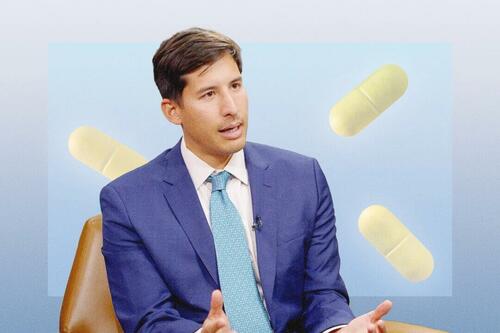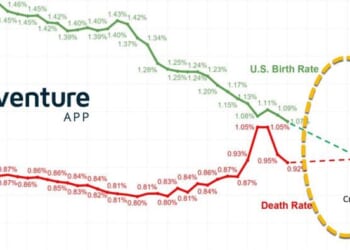Authored by Cara Michelle Miller via The Epoch Times (emphasis ours),
For years, people have been told their sadness was the result of a chemical imbalance—a fixable flaw—like how insulin helps people with Type 1 diabetes.
The “chemical imbalance” theory has shaped mainstream treatment for depression, fueling widespread prescriptions of antidepressants. Yet, psychiatrist and former U.S. Food and Drug Administration (FDA) medical officer Dr. Josef Witt-Doerring said the theory, popularized in the 1950s, has never been proven and lacks scientific backing.
In a recent episode of American Thought Leaders, Witt-Doerring told host Jan Jekielek that relying on the chemical imbalance narrative can lead to overmedication, often with worse—not better—outcomes for patients, and that the way antidepressants are prescribed needs reform.
Origins of the Chemical Imbalance Theory
The chemical imbalance theory first emerged with doctors’ amazement that a tuberculosis drug called iproniazid seemed to energize and lift patients’ moods. Psychiatrists soon tested the drug on people with depression and saw similar improvements.
Iproniazid worked by preventing the breakdown of neurotransmitters—chemical messengers such as serotonin, norepinephrine, and dopamine—thereby increasing their levels. Researchers theorized, based on their observations, that depression must be caused by a shortage of these chemicals in the brain.
The idea revolutionized psychiatry, offering a biological explanation for emotional suffering and paving the way for widespread prescription of antidepressants. For decades, the chemical imbalance theory dominated both medical practice and public perception.
However, once accepted as a medical fact, the theory has begun to crumble.
“A lot of people think that they [antidepressants] work in that they are fixing this imbalance; they are restoring them to a normal state,” Witt-Doerring said. However, growing evidence disputes this.
For instance, a 2022 systematic review published in Molecular Psychiatry found no consistent evidence that low levels of serotonin cause depression. Additional clinical studies have likewise failed to identify reliable differences in neurotransmitter levels between people with and without depression.
“There is no way to differentiate patients who are depressed from those who are not depressed using any objective markers,” he added. “That’s why when you go and see a psychiatrist or a family medicine doctor, they’re not doing blood tests, they’re not scanning your brain—they’re essentially just doing a checklist.”
What Antidepressants Do
Witt-Doerring said that antidepressants don’t correct an underlying defect but instead create a predictable drug effect. For the most common class—selective serotonin reuptake inhibitors (SSRIs)—the effect is often one of emotional blunting or numbing.
SSRIs boost the amount of serotonin in your brain. Serotonin is a chemical that helps manage your mood and emotions. Normally, once serotonin delivers its message, it is taken back into the brain cell that released it. SSRIs slow down that process, so more serotonin stays active between brain cells for a little longer.
Having more serotonin can help even out your mood and ease feelings of anxiety or sadness. However, it can also make emotions feel somewhat flat—you might notice less excitement or joy, as well as less distress—sometimes referred to as emotional numbing or blunting.
For some patients, the dulling of emotional extremes can be therapeutic. For others, it suppresses emotions that need to be processed, leaving underlying issues unresolved.
“If you are in a state where you’re having a lot of anxiety, and you take a drug and it kind of constricts that, it sort of numbs that out, you’re going to feel better,” he said. “And if you’re highly suicidal, you might even say the medication saved your life.”
Hidden Risks of Long-Term Antidepressant Use
Relief derived from antidepressants can come at a cost. Over time, the body adapts to the medication’s effects.
“People become tolerant to them,” Witt-Doerring said, explaining that the drug starts to wear off, doses are increased, and “eventually you’re maxed out—still struggling with the same issues that led you to seek help in the first place.”
To compensate, other medications—mood stabilizers, sleep aids—may be added, a practice known as polypharmacy. However, stacking drugs can also mask, rather than resolve, the underlying problem.
“And this is why you hear that some people are on four, five, six medications,” he said.
When medications lose effectiveness, the body has simply adapted, yet patients are often told they have treatment-resistant depression and are prescribed more drugs—continuing the cycle. The more medications a person takes, the higher the chance of unpleasant or dangerous side effects—and it can become harder to tell which drug is causing which reaction.
* * * Try natural lithium instead…
Higher doses or multiple drugs may also increase the risk of agitation, impulsivity, or, in rare cases—especially among young people—new or worsening suicidal thoughts during the first few weeks of treatment. The risk is greatest for teens and young adults under 25, which is why antidepressants carry an FDA black box warning for suicidal thinking in this age group.
Meanwhile, life’s problems—stressful relationships, work challenges, or unresolved trauma—often remain unaddressed.
The Dangers of Withdrawal
Many people decide to come off antidepressants at some point—sometimes because they’re feeling better, want fewer side effects, or find the medication isn’t helping as much as it used to.
Stopping antidepressants can be challenging. Some people experience withdrawal effects—such as mood changes, dizziness, or “brain zaps”—when they try to come off the medication. Research suggests that nearly a quarter of people who take SSRIs long-term have withdrawal symptoms lasting more than three months.
Witt-Doerring estimates that 5 to 10 percent of people need medical support to safely stop.
He cited the case of Bryson Burks, a promising college athlete prescribed three antidepressants for pain after a football injury—though he’d never had depression—a practice sometimes used for chronic pain.
Burks—known for his leadership, generosity, and aspirations—appeared happier and stronger after recovering from his injury, according to his mother. However, when instructed to taper off the medications, reducing one pill each week, he developed sudden, extreme mood swings and tragically died by suicide during the fourth week, just before his twentieth birthday. His mother has since spoken publicly about the risks of abrupt or poorly monitored discontinuation of psychiatric medications.
Witt-Doerring also noted that, in rare but serious cases, abrupt medication changes have been linked to extreme agitation or manic reactions. Some high-profile tragedies have prompted questions about whether sudden shifts in psychiatric medication could play a role.
After the 2012 Aurora, Colorado, theater shooting, forensic experts observed that the perpetrator, James Holmes, showed marked behavioral changes after his antidepressant dosage was increased shortly before the attack.
Psychiatrist David Healy, who later interviewed Holmes, said that the timeline warranted closer scientific scrutiny, according to Witt-Doerring. While the courts did not find the medication change to be a legal cause of the violence, the case underscored the importance of careful monitoring whenever antidepressant doses are adjusted or discontinued—particularly for young or vulnerable patients.
Many patients can taper off antidepressants with only temporary discomfort. “Within a couple of months, they have really nasty withdrawal,” but their brains adapt and they move on, Witt-Doerring said. “I would say that they have very healthy, elastic brains.”
A smaller group experiences severe symptoms—insomnia, agitation, tinnitus, cognitive fog—that can last months or even years. For them, a standard two-month taper is too abrupt.
Because doctors rarely expect lingering withdrawal, these symptoms are often mistaken for relapse. Patients are placed back on medication, convinced they cannot live without it, Witt-Doerring said.
In rare but devastating cases, people develop what’s known as protracted withdrawal, a long-term hypersensitivity of the nervous system. “It’s like you’ve had a concussion,” Witt-Doerring said. “It takes 18 months to two years, sometimes longer, for the nervous system to recover.”
Stories like Burks’—who was not Witt-Doerring’s patient—have reshaped how he practices psychiatry. He now runs a tapering clinic specifically for people navigating the withdrawal process, providing careful monitoring and guidance.
His advice to anyone considering coming off antidepressants is to do so gradually—over many months, sometimes years. The safest approach is to proceed slowly and with close support.
Rethinking Care
Today, most psychiatric medications are prescribed by family doctors, gynecologists, and other front-line providers working under intense time pressure. The system often prioritizes quick fixes over long-term wellness.
Witt-Doerring envisions a different care model—embedded in primary care—but focused on “dealing with the real problems.” Patients would receive structured education and group guidance on four areas that drive anxiety and depression: healthy relationships, meaningful engagement—through work, faith, or community—physical health, and substance use.
“Imagine a family doctor saying, ‘You’re struggling with relationships and health issues—here’s an assessment, and then you can join a group to learn and talk through these problems with professionals,’” he said.
“That takes the pressure off prescribing medication as the only solution and gives patients real tools to improve their lives.”
Loading recommendations…


















